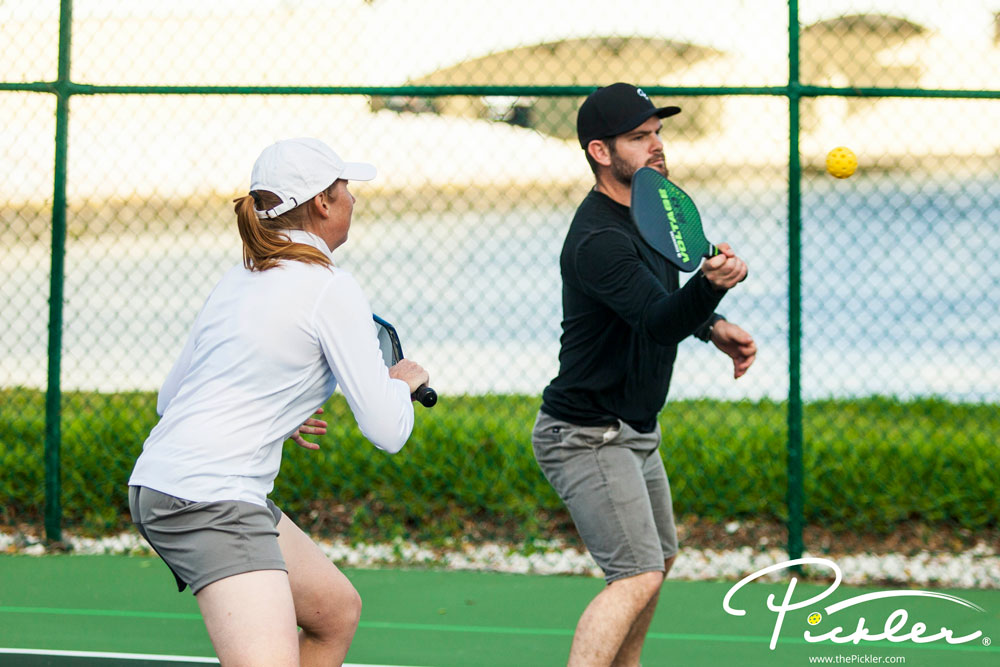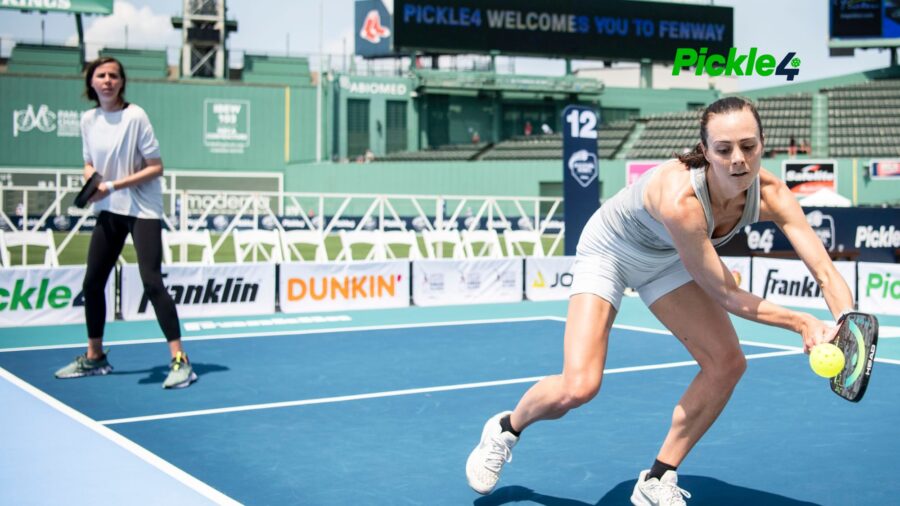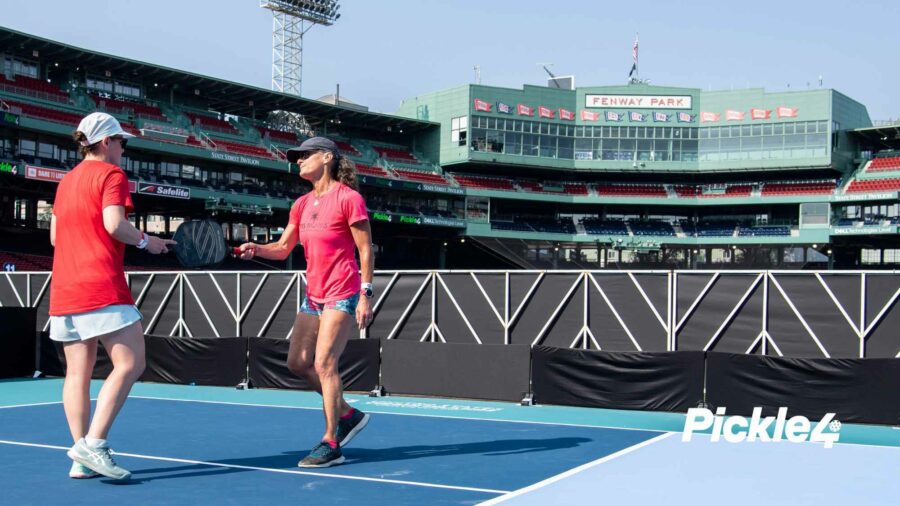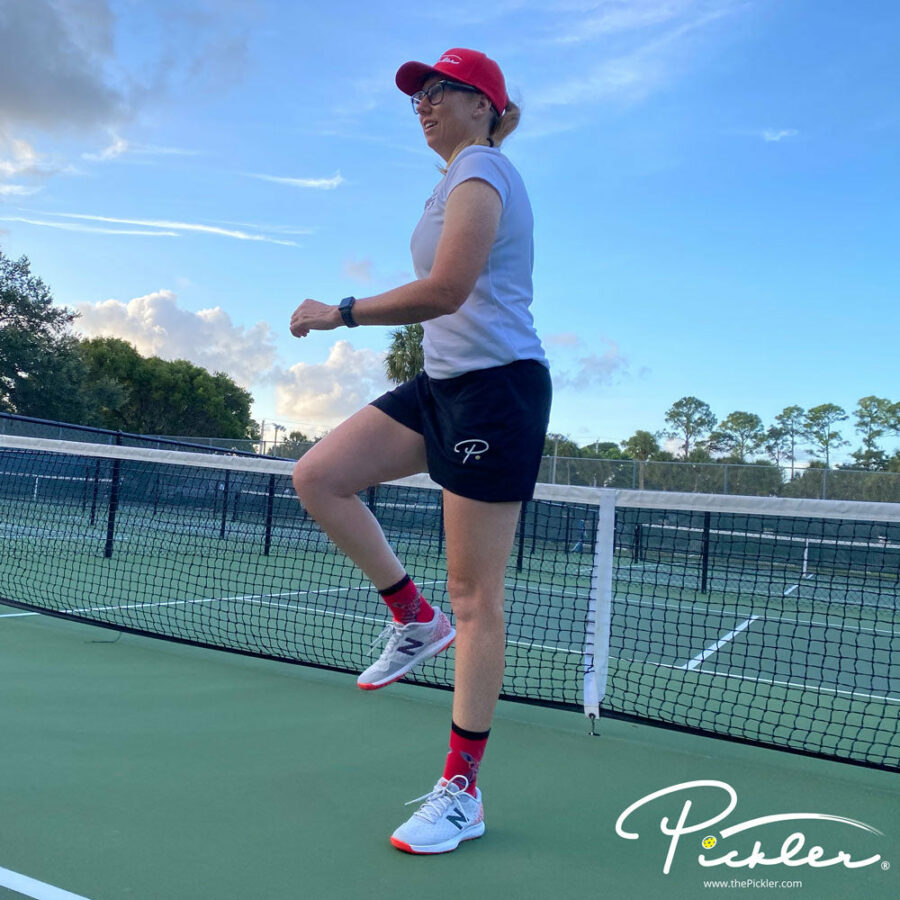If you play doubles pickleball (as opposed to singles pickleball), then communication has to be an important part of your game. And, this communication should take many forms:
Before a Pickleball Game
If you have never played with your partner, then it will be important to have a quick conversation about your styles of play. For instance:
- I will drive most third shots.
- I am known to throw up a lob.
- I like to speed up the ball.
- I like to stay in the dink.
- I like to stack. Do you want to stack?
That way you and your partner both have some idea of what to expect on the court and are not totally surprised by the shot selection.
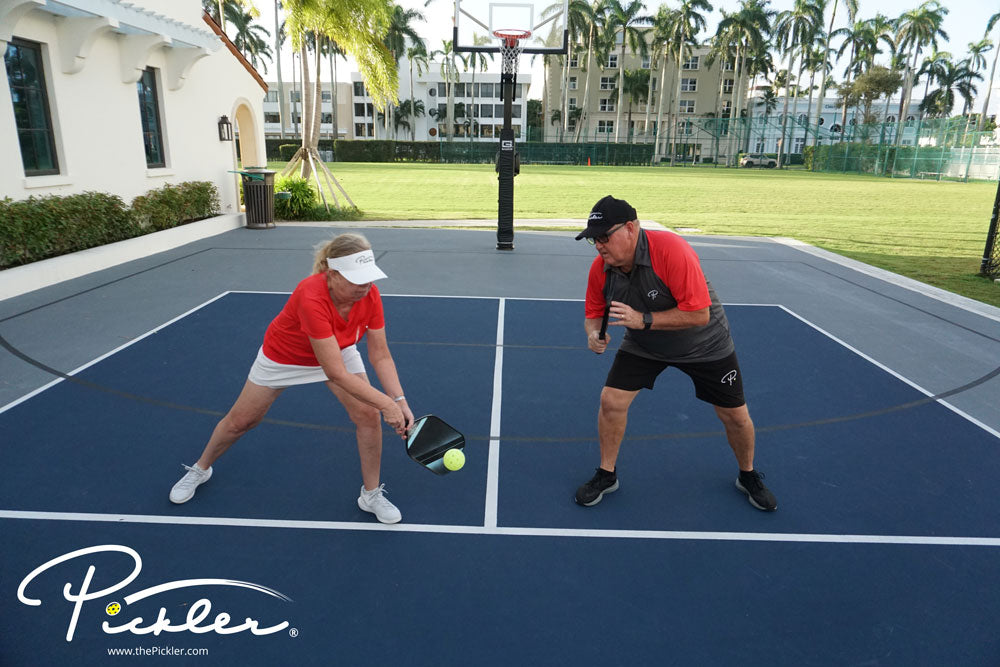
It is also important to have a conversation about the middle. New teams are particularly prone to losing points down the middle of the court. So, before a game with a new partner, be sure to discuss who will cover the middle, so you do not lose points for lack of communication. This can be as simple as the player with the forehand in the middle takes the middle.
Lastly, you and your partner should communicate any strategy for the game, particularly in a competitive play environment. What is the strategy against your opponents? When you and your partner are working together and on the same page for strategy, rather than fighting each other on strategy, you will certainly be prone to more success on the court.
During a Rally on the Pickleball Court
You and your partner should also be communicating during a rally. This includes:
- Whether or not to let certain shots go by that will be landing out of bounds—“OUT” or “BOUNCE IT!”;
- Who is taking which shots—particularly those in the middle of the pickleball court—“YOU” or “ME!”;
- Who is running down a lob and whether or not to switch sides of the pickleball court as a result of that lob—“SWITCH!”;
- If you see a short shot from your opponents and you need to race in toward the Kitchen line—“UP!”;
- If you hit a poor shot and your opponents are about to go on the offensive against you and your partner—“HEADS UP!”
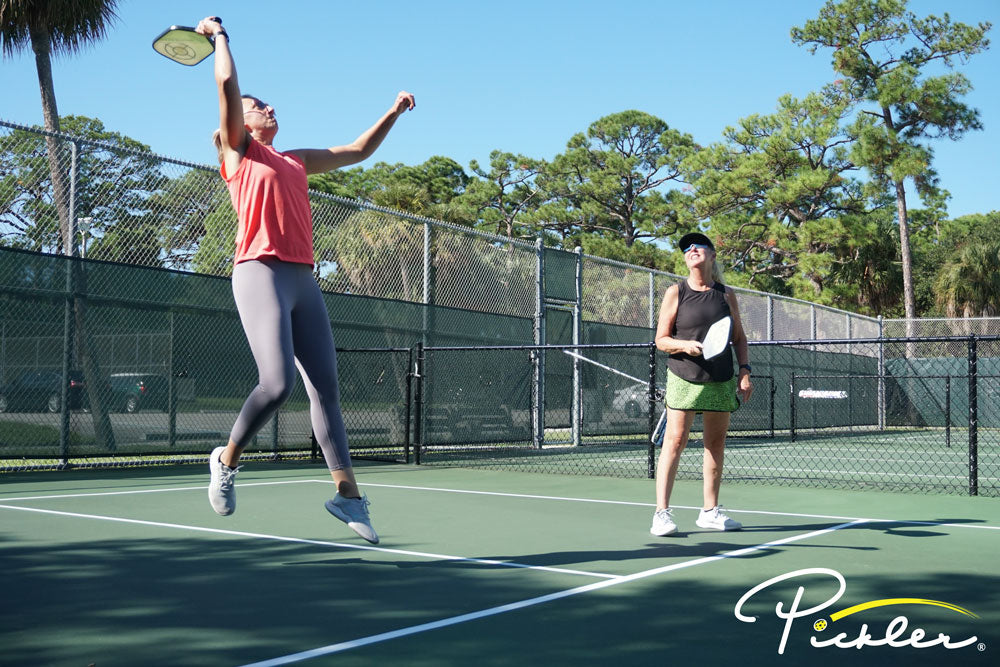
Things happen so quickly on the pickleball court, so it is important to vocalize what you see in order to act fast and act together. By communicating during a rally, you and your partner will be better able to work as a team and work as one.
Between Points on the Pickleball Court
Communication on the pickleball court also happens between points. You and your partner should be evolving and adjusting your style of play on every point in order to keep up with what your opponents are doing. Oftentimes, the strategy that is effective at the beginning of a pickleball game will not be effective at the end of the pickleball game. So, work with your partner to continuously tweak, change, and improve your strategy throughout the entire game. To do this, you will need to communicate with your partner. Speak up on any tendencies that you see and work together to make sure you have the best strategy going into every point.
Also, do not forget to vocalize a few words of encouragement for your partner throughout the game—everyone likes to be cheered on! And, positivity breeds positivity… and likely better play.
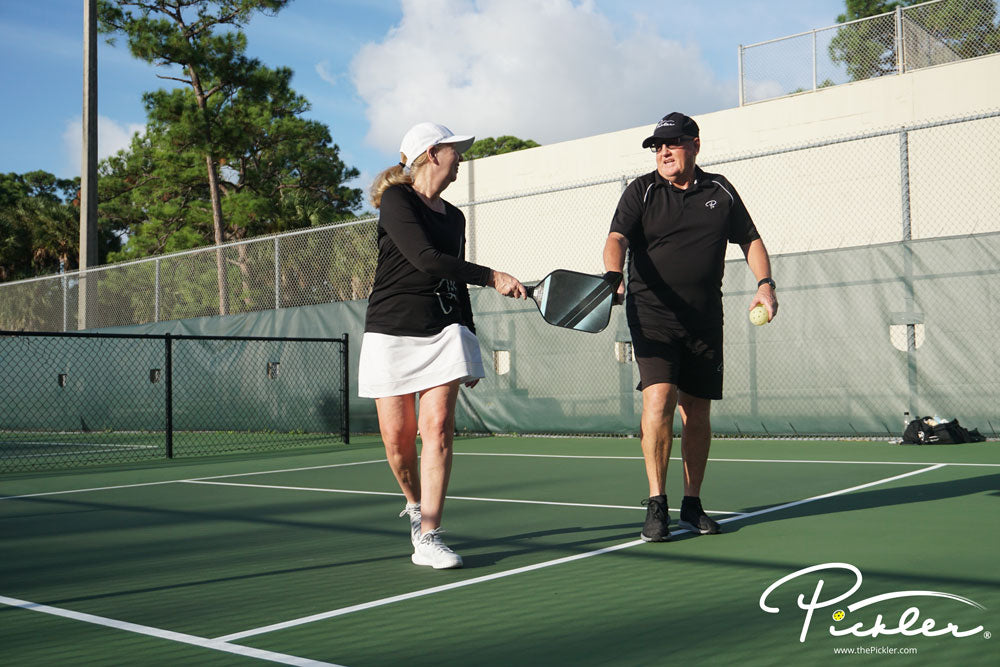
After a Pickleball Game
Even if the pickleball game is over, your communication with your partner shouldn’t be. Whether you win or lose, give kudos to your partner for a great game and for taking the time to step on the court with you. Even if you lost and it was “all your partner’s fault,” kindness goes a long way and you never know when the shoe will be on the other foot.
And, if you decide you will play another game with your partner in the future, consider having a discussion about how each of you could improve for the next time you hit the courts. Be sure to be positive and constructive (rather than overly critical). Also, be open to constructive criticism of your own game—no matter how good you are, one of the best things about pickleball is that there is always room to improve and grow your game.
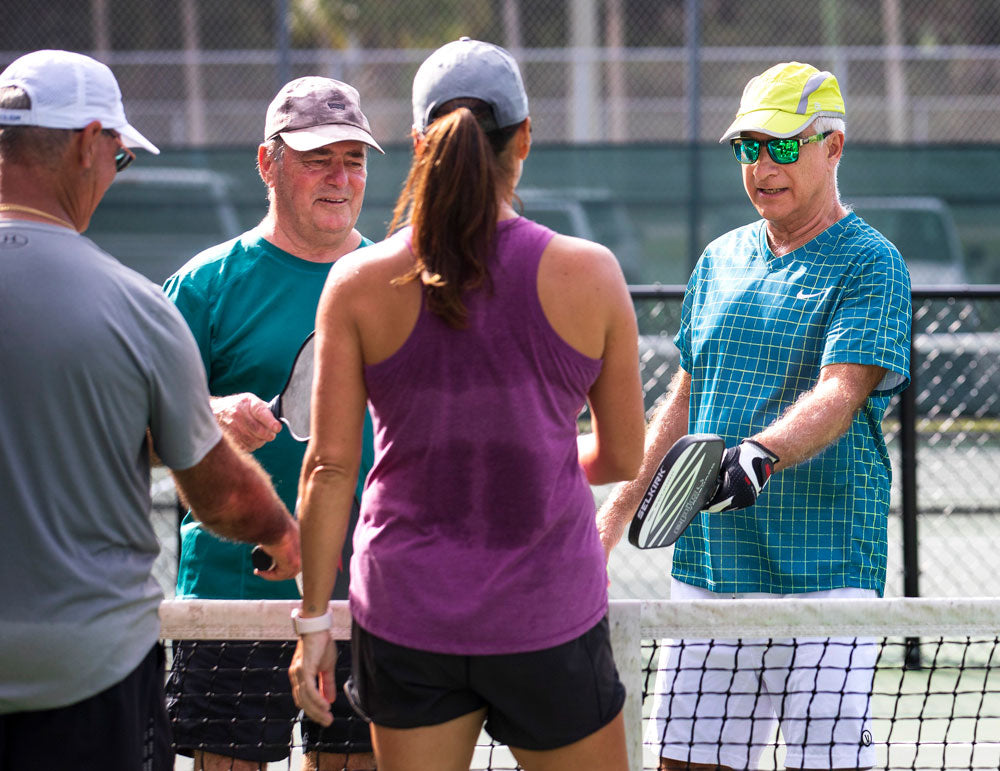
Non-Verbal Communication on the Pickleball Court
To this point, we have focused on verbal communication. However, what may be even more powerful than verbal communication on the pickleball court is non-verbal communication. Non-verbal communication can be “louder” than verbal communication. So, pay attention to your body language and facial expressions. Avoid negative body language (e.g. shrugging arms, turning your back on your partner, etc.), as well as negative facial expressions (e.g., eye rolls, sighs, etc.). As alluded to above, positive words of encouragement will likely go farther in helping motivate your partner to play better than critical or negative words. The same is true for non-verbal communication. Watch your non-verbal communication on the court and make it positive (e.g., smiles, fist pumps, hand claps, etc.).
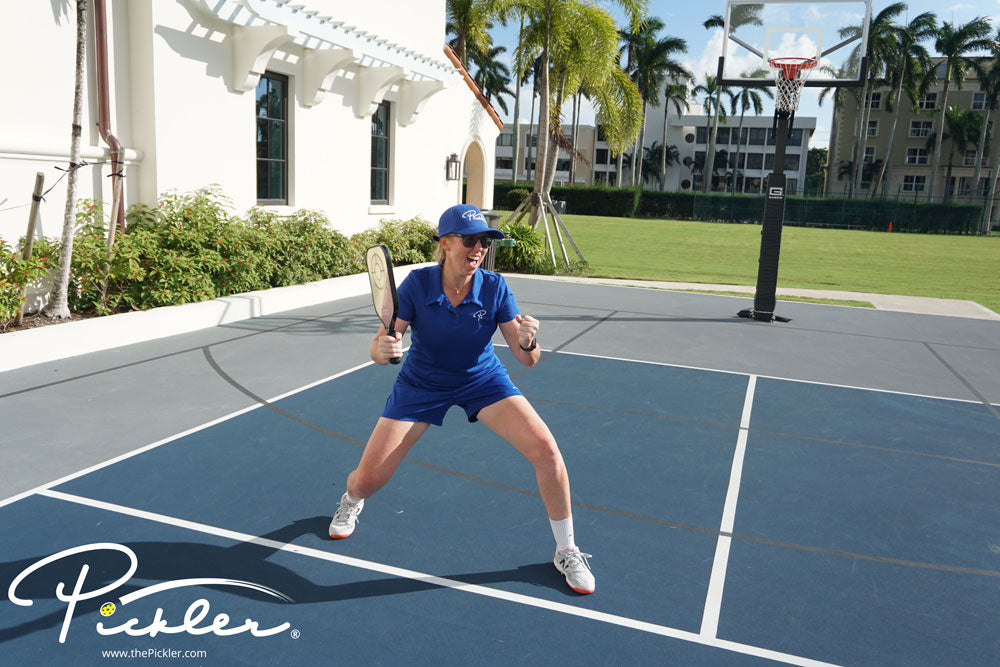
Communication to Be a Good Pickleball Partner
Now, every player is different on the pickleball court. Your communication style may need to shift from one partner to the next. But, no matter what, you will need to communicate in order to learn your partner’s preferences and adapt, so that you can be the best partner you can be.
Partner communication is so important to being a good partner on the pickleball court—and to your pickleball game overall. In fact, it is even one of the six tips for being a good pickleball partner in Frank Cerabino’s laugh-out-loud book, I Dink, Therefore I Am: Coming to Grips with My Pickleball Addiction (available on Amazon and a great read (or gift!) for any pickleball player). We challenge you not to laugh when reading the excerpt below for six tips to be a better pickleball partner:
The important thing is that whomever your pickleball partner becomes, it’s a good idea if you treat him or her with the kind of respect, attention and care that allows your relationship to stay strong.
In other words. Don’t be a jerk to your pickleball partner.
I think I can get you started down this road. Here are six tips that will give you the best shot at making your pickleball relationship work.
Tip No. 1: The two of you are only into pickleball as much as the least-interested member of the couple. If you want to play five nights a week, and your partner is fine with one night a week, there may be a limit to your pickleball compatibility. Something’s gotta give. Or you may require an open pickleball partnership.
And by that I mean, you may want to find another pickler on the side.
Tip No. 2: One of you is going to be better than the other one. If you’re the more skilled partner, be careful how you behave.
This means there will be times during your game when your partner will make a mistake and lose a point by failing to return a ball that you are sure you would have hit back as a winner.
Never, never allow this to be expressed in either verbal or non-verbal communications. You may think you’re a model of sportsmanship by not saying anything, but if you throw up your paddle, even for a second, or exhale audibly, you might as well have shouted, “I would have put that one away!”
Tip No. 3: No coaching on the court. If you pause the flow of a game to offer your partner a little tutorial on how he or she screwed up the last point, you are making things worse.
It’s best to operate on the theory that everybody’s doing as best as they can, and people know when they screw up.
On the other hand, “Would it kill you to step right up to the non-volley-zone line when the other team is serving to me!”
“Sorry. I didn’t mean that. Sure, continue to stand back that extra foot and guarantee that more of your volleys will end up in the net as a result of your poor court placement.”
“Oops, sorry again. I didn’t mean that, either. I mean, yes I meant that, but I didn’t mean to actually hear those words coming out of my mouth.”
See what happens? It may look like a court, but it’s a minefield.
Tip No. 4: If you ever “poach” a ball by reaching across the court to hit a ball that your partner could have clearly hit, and the ball you hit goes out, or is easily returned by the other team, apologize at the first break in play.
“I’m sorry,” you should say. “I should have let you hit that. I got too carried away there. I’ll try to be better next time.”
Poaching is tricky. The best pickleball players poach a lot. And they don’t get upset about it. It’s routine, and part of the game for high-level players.
If you watch games among 5.0 players, which I’ll admit, I do way too often, you’ll frequently see the weakest player on each side being “targeted” by the other team.
“Targeting” means that the other team is trying to hit every ball to the weakest of the two opponents.
The more-skilled players get around this by pinching way over to the other side of his or her court, intentionally poaching anything hitable and daring the other team to try to hit one on the more open side of the court.
Like I said, this is part of the game at its highest levels. The weaker players expect it, and aren’t upset by it.
But in recreational play, “targeting” can sometimes be seen as unsportsmanlike, or at least an area of friction in what otherwise would be a relaxing game.
You’re all out there supposedly to have fun. There are no trophies or cash prizes for winning. And yet, in many rec games, you’ll see a weak player being mercilessly targeted. Shot after shot is directed to him or her, while the more-skilled partner just stands there watching.
In games where the weaker player is obviously targeted, the stronger player is tempted to end his or her role as a spectator by reaching over to poach some of those balls heading for his or her partner.
Resist this temptation.
I say this from experience. I have been on both sides of this poaching experience in rec play. I’ve been the poacher and the poachee.
And I can report it’s not good for your relationship with your partner to poach a ball and smash it brutishly into the back fence or a foot wide of the court. And it’s even worse, to have your partner do that to you.
I try to make a conscious effort not to target the weaker player when I play. The key word in that sentence is “try.”
My success in this endeavor usually is related to the score of the game and my view of humanity on the day in question.
If I’m feeling like Mother Teresa in an SPF-50 shirt and court shoes, I spread the love of my returns. But if I’m in my default mode, a cranky 66-year-old guy from South Florida waiting for the morning’s psyllium husks to kick in, I’ve already sussed out who to target by the third serve.
Sorry, stranger. You caught me on a day when I wasn’t the best person I could be. Incoming!
But I do think that, even if targeting is unsportsmanlike in rec play, it achieves something valuable: It makes the weaker player stronger by being given so many more opportunities to return balls than his or her partner.
I keep telling myself that. I’m not sure if I believe it yet, but it’s helping.
The thing to remember here is that it’s not the end of the world that your partner is being targeted. Try not to poach.
Unless you just can’t help it. Sometimes, you gotta be bad. Who am I to judge?
Tip No. 5: The time to advise your partner not to hit a ball that’s going out of bounds is while the ball is in flight before he or she has a chance to swing at it.
I write this as an offender of my own tip. I sometimes find myself after a rally is finished telling my partner, “You should have let that last one go. It was heading out.”
That’s jerk behavior. What I should have done was yell “No!” or “Let it go!” or “Bounce it!” while my partner was getting ready to hit the ball.
That’s being a good partner. But if you miss your chance to advise your partner about a potential out-ball while the play is in progress, you ought to just clam up after the ball is dead.
If your partner asks you, “Was that one I hit going out?” after the rally, you can be honest.
But I don’t recommend it.
“Maybe, but it’s hard to say,” is a better answer. “It was worth a try.”
For the record, I plan to say that one day.
Tip No. 6: Have a heart-to-heart discussion about a difficult subject with your pickleball partner.
When considering a marriage partner, it helps to discuss your respective attitudes toward raising children before you say, “I do.”
Similarly, in pickleball, there are things you should discuss with your partner before the two of you say, “Zero, zero, two.”
I’m talking about the middle of the court. It’s that place where neither of you are standing. It breaks up more pickleball relationships than anything else.
If you think games of pickleball are won and lost by the ability of players to zing accurate returns down the alleys, just nipping on or inside the sidelines, you haven’t been watching or playing enough pickleball.
Points are routinely scored by well-placed balls between the two doubles partners down the middle of the court. It’s almost meaningless for pickleball partners to say, “This is my side, and that’s your side.”
That’s because there are too many balls that fall within an inch or two of that 15-foot-long center line that goes from the non-volley zone line to the baseline.
And some of those balls are angling diagonally across your side of the court, not traveling parallel to the sidelines.
If your focus is on trying to be the reincarnation of Emily Post on a pickleball court, you’re going to screw up a lot of winnable points.
Instead of divining the precise landing spot of an incoming return in order to determine who is entitled to hit the ball back, you and your partner should know this in advance.
It will prevent what ranks as one of the most mortifying events in a pickleball game — and one that happens during many games.
It’s that point in a rally when both teammates eye an incoming return down the middle of the court and assume it’s the other person’s ball. They’ll both stand there, paddles frozen in the air, as the returnable ball bounces lazily between them without either player making a move to hit it.
The way to prevent this from happening is to have “the talk” with your pickleball partner before you start to play.
If you’re both right-handed players, the player on the left side of the court as you’re facing the net should, in most cases, take the middle balls because his or her forehand is naturally in the middle of the court.
Most players prefer their forehand, where they have more power and control than their backhand side.
The right-handed player on the right side of the court as you’re facing the net would have to hit backhand shots for middle balls.
Things are a little more confusing when one player is left-handed, like me.
When I play with a right-handed partner, we both have forehand shots when the righty is on the left side of the court facing the net.
And neither of us have forehands when we switch sides.
This means we need to talk. This is my predicament when I play with my wife. Jo is right handed. It feels natural for both of us to want those middle balls when I’m on the right side of the court facing the net and she’s on the left side.
And it also is tempting for the both of us to defer when we’ve switched sides.
How do we overcome this? I’d like to say that after 40-plus years of marriage we’re like a fine-tuned watch that is so used to the two-as-one dynamic that we instinctively know when to follow through and when to back off.
But the truth is, we lose a lot of points this way. Even so, we haven’t given up on each other.
Like dancing. It takes patience. And practice, and in the end, the fun you’re having while doing it is all that matters.
And for that, it helps to find the right partner. Good luck.
Heed Frank’s advice and be a better partner out on the pickleball courts. It may inspire others to do the same. And, don’t forget to communicate!
***
Frank Cerabino is a long-time columnist for the Palm Beach Post in Florida, a pickleball addict like the rest of us, and a newly published author. Check out Frank’s newly released book, I Dink, Therefore I Am: Coming to Grips with My Pickleball Addiction (available on Amazon and a great read (or gift!) for any pickleball player), for pickleball tips and laughs!
